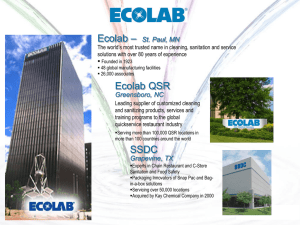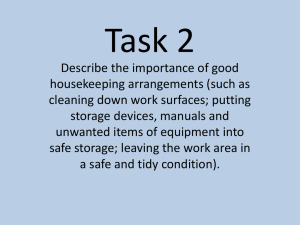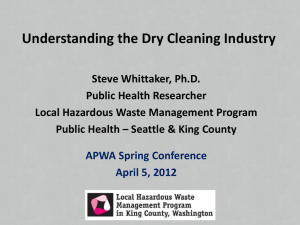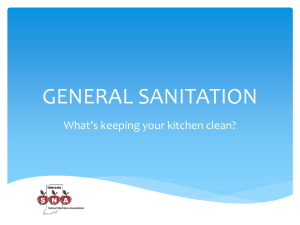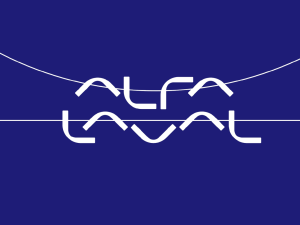Tankcleaning With IMPACT - Great Lakes Water Conservation
advertisement
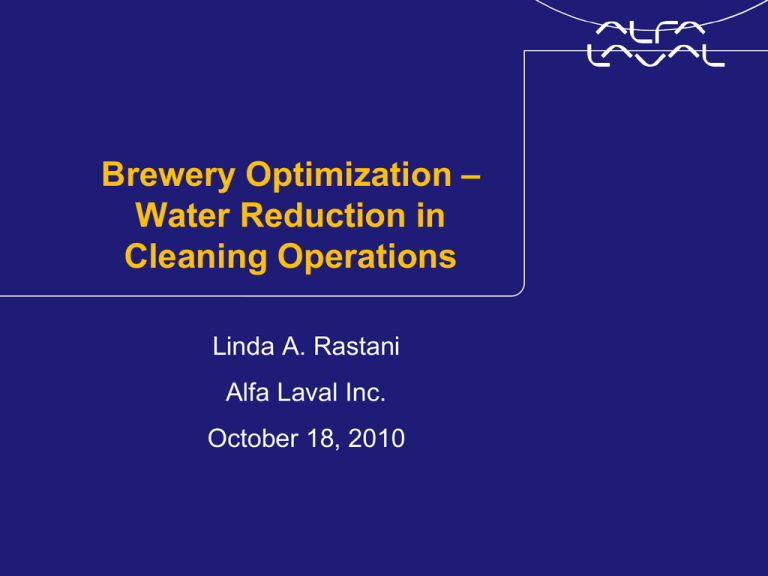
Brewery Optimization – Water Reduction in Cleaning Operations Linda A. Rastani Alfa Laval Inc. October 18, 2010 How do you conserve resources while effectively cleaning ? The tank must be clean=> effective cleaning meets the following requirements: • • • • • low consumption of fresh water low consumption of cleaning agents minimum of energy consumption Low amount and pollution level of waste water Reduce cleaning process time www.alfalaval.com The Optimal Cleaning Operation. • turn around as quickly as possible. • Using a minimum of water, chemicals, energy • producing a minimum of waste water. • Being able to validate the process. www.alfalaval.com TACT Cleaning Parameters Traditional TACT - Jet Head Approach Action Time Cleaning Impact (impingement) Action Temperature Action Chemical Concentration Reduce: Time, Chemicals & Temperature Improve: Action & Coverage Surface Coverage Slide 4 www.alfalaval.com Comparing Static Spray Ball with Rotary Jet Head Cleaning with Static Spray Ball Cleaning with Rotary Jet Head Concentration Time Mechanics Temperature www.alfalaval.com Static Spray Ball Rotary Spray Head Rotary Jet Head Coverage: Means: Cascading Swirling fan Index Pattern Effect: Partial Partial to full Full Action: Low Medium High % Resources used 100% 70-75% Slide 6 <50% in most cases www.alfalaval.com Energy Labelgy Label A D G www.alfalaval.com << Back to Total Cost of Ownership start page. Static Spray Ball Slide 8 www.alfalaval.com Cleaning Technology P≈V 1. Pressure is the driving force 1. The flow is turning the tank cleaning machine 2. Pressure is converted to water jet velocity 2. High Wall Shear Stress Zone 3. Machine gearing makes the indexed criss-cross pattern Water Jet t d d Wall Shear Stress under Turbulent Flow Conditions Min. 40 Pa at r = 11 cm Slide 9 www.alfalaval.com Rotary Jet Head Cleaning Technology - Attack of residues Slide 10 www.alfalaval.com Mash Tun Required number of Rotary Jet Heads Type number RJH 2 4 x 5.2mm, 50 USGPM @ 75 PSIG Slide 11 www.alfalaval.com Mash Tun Slide 12 www.alfalaval.com Mash Tun RJM Standard cleaning water rinse 10 Min water rinse caustic recirc. 60 Min caustic recirc. 5 Min 20 water rinse acid recirculation water rinse Total 9 Min 18 Min water rinse 9 Min Min acid recirculation 9 Min 5 Min water rinse 9 Min 100 Min Total 54 Min 100 USGPM = 1,600 USG per Cleaning to drain. 100 USGPM = 900 USG per Cleaning to drain. Net Savings/Cleaning = 700 USG x # Boils (Or Cleaning Cycles) Example = 1 cleaning/day x 700 USG = 176,400 USG/yr (252 days) saved! www.alfalaval.com Mash Tun Added value by using Rotary Jet Heads • Cleaning time can be reduced by 46 % • Shorter down time • Total costs can be reduced by 60 % • Higher cleaning standard Slide 14 www.alfalaval.com Kettle Required number of Rotary Jet Heads Cylindrical Type RJH-BKV number 3 4 x 7mm, 58 UGPM, 75 PSIG Slide 15 www.alfalaval.com Kettle RJH BKV • The heating surfaces are hard to keep efficiently clean • Many have internal heaters which do have “difficult-to-clean areas” • Many do have Static Spray Balls which do not clean well and use large fluid volumes and strong chemicals Slide 16 www.alfalaval.com Kettle RJH - BKV Standard cleaning water rinse 10 Min water rinse caustic recirc. 90 Min water rinse 10 acid recirculation water rinse Total 13,5 Min caustic recirc. 36 Min Min water rinse 9 Min 20 Min acid recirculation 13,5 Min 10 Min water rinse 9 Min 130 Min Total 81 Min 170 USGPM = 3,230 USG to drain 175 USGPM = 2,365 USG to drain Net Savings/Cleaning = 865 USG x # Boils (Or Cleaning Cycles) Ex: 1 cleaning/day x 865 USG = 217,980 USG/yr (252 days) saved! Slide 17 www.alfalaval.com Kettle Added value by using Rotary Jet Heads • The cleaning time can be reduced by 37 % • Shorter down time • The costs can be reduced by 35 % • Validation possibility Slide 18 www.alfalaval.com Benefits using RSH & Jet Heads • Cleaning standard Less than 1 year pay-back – Repeatable high cleaning standard • Volume of water, waste and detergents – Up to 50% Flow reduction – Up to 75% Water Consumption Reduction – Up to 75% Detergent Consumption reduction • Time – Up to 50% Cleaning time reduction – allowing more time for production Cleaning Cleaning Production Production Slide 19 www.alfalaval.com Thank You


